What Animal Can Have As Many As 15 Sexes
Chapter 13: Introduction to Creature Reproduction and Evolution
thirteen.1 How Animals Reproduce
Learning Objectives
By the end of this section, you will exist able to:
- Draw advantages and disadvantages of asexual and sexual reproduction
- Discuss asexual reproduction methods
- Talk over sexual reproduction methods
- Discuss internal and external methods of fertilization
Some animals produce offspring through asexual reproduction while other animals produce offspring through sexual reproduction. Both methods have advantages and disadvantages. Asexual reproduction produces offspring that are genetically identical to the parent because the offspring are all clones of the original parent. A unmarried individual tin produce offspring asexually and large numbers of offspring can be produced speedily; these are 2 advantages that asexually reproducing organisms have over sexually reproducing organisms. In a stable or predictable environment, asexual reproduction is an effective means of reproduction considering all the offspring will be adapted to that environment. In an unstable or unpredictable environment, species that reproduce asexually may exist at a disadvantage because all the offspring are genetically identical and may not exist adjusted to dissimilar conditions.
During sexual reproduction, the genetic material of two individuals is combined to produce genetically diverse offspring that differ from their parents. The genetic multifariousness of sexually produced offspring is idea to requite sexually reproducing individuals greater fitness because more of their offspring may survive and reproduce in an unpredictable or changing environment. Species that reproduce sexually (and accept separate sexes) must maintain 2 different types of individuals, males and females. Only half the population (females) can produce the offspring, so fewer offspring will be produced when compared to asexual reproduction. This is a disadvantage of sexual reproduction compared to asexual reproduction.
Asexual Reproduction
Asexual reproduction occurs in prokaryotic microorganisms (bacteria and archaea) and in many eukaryotic, single-celled and multi-celled organisms. There are several means that animals reproduce asexually, the details of which vary among private species.
Fission
Fission, also called binary fission, occurs in some invertebrate, multi-celled organisms. It is in some ways analogous to the process of binary fission of unmarried-celled prokaryotic organisms. The term fission is practical to instances in which an organism appears to separate itself into two parts and, if necessary, regenerate the missing parts of each new organism. For instance, species of turbellarian flatworms unremarkably called the planarians, such as Dugesia dorotocephala, are able to separate their bodies into caput and tail regions and then regenerate the missing one-half in each of the two new organisms. Ocean anemones (Cnidaria), such every bit species of the genus Anthopleura (Effigy xiii.two), volition divide along the oral-aboral axis, and ocean cucumbers (Echinodermata) of the genus Holothuria, will divide into two halves beyond the oral-aboral centrality and regenerate the other one-half in each of the resulting individuals.
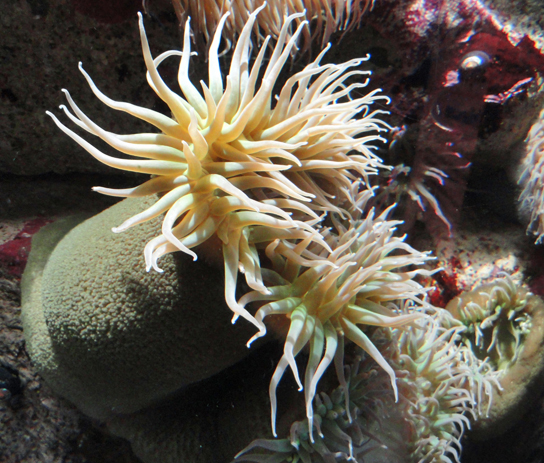
Budding
Budding is a form of asexual reproduction that results from the outgrowth of a part of the body leading to a separation of the "bud" from the original organism and the formation of 2 individuals, ane smaller than the other. Budding occurs commonly in some invertebrate animals such every bit hydras and corals. In hydras, a bud forms that develops into an adult and breaks abroad from the master body (Effigy thirteen.3).
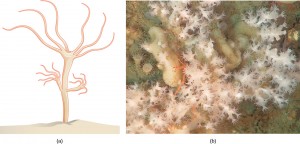
Concept in Action

View this video to run into a hydra budding.
Fragmentation
Fragmentation is the breaking of an individual into parts followed by regeneration. If the animal is capable of fragmentation, and the parts are big enough, a separate individual will regrow from each part. Fragmentation may occur through accidental damage, impairment from predators, or as a natural form of reproduction. Reproduction through fragmentation is observed in sponges, some cnidarians, turbellarians, echinoderms, and annelids. In some sea stars, a new individual can be regenerated from a broken arm and a piece of the central disc. This ocean star (Figure 13.4) is in the process of growing a complete sea star from an arm that has been cutting off. Fisheries workers have been known to try to kill the body of water stars eating their clam or oyster beds past cut them in half and throwing them back into the body of water. Unfortunately for the workers, the two parts tin each regenerate a new half, resulting in twice as many sea stars to prey upon the oysters and clams.
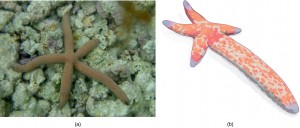
Parthenogenesis
Parthenogenesis is a form of asexual reproduction in which an egg develops into an individual without being fertilized. The resulting offspring can be either haploid or diploid, depending on the procedure in the species. Parthenogenesis occurs in invertebrates such as water fleas, rotifers, aphids, stick insects, and ants, wasps, and bees. Ants, bees, and wasps utilise parthenogenesis to produce haploid males (drones). The diploid females (workers and queens) are the issue of a fertilized egg.
Some vertebrate animals—such as sure reptiles, amphibians, and fish—likewise reproduce through parthenogenesis. Parthenogenesis has been observed in species in which the sexes were separated in terrestrial or marine zoos. Two female Komodo dragons, a hammerhead shark, and a blacktop shark have produced parthenogenic young when the females have been isolated from males. It is possible that the asexual reproduction observed occurred in response to unusual circumstances and would commonly not occur.
Sexual Reproduction
Sexual reproduction is the combination of reproductive cells from two individuals to form genetically unique offspring. The nature of the individuals that produce the 2 kinds of gametes tin can vary, having for example separate sexes or both sexes in each individual. Sex activity determination, the machinery that determines which sexual activity an individual develops into, also can vary.
Hermaphroditism
Hermaphroditism occurs in animals in which one individual has both male and female reproductive systems. Invertebrates such as earthworms, slugs, tapeworms, and snails (Figure xiii.5) are often hermaphroditic. Hermaphrodites may self-fertilize, only typically they will mate with another of their species, fertilizing each other and both producing offspring. Cocky-fertilization is more common in animals that have limited mobility or are not motile, such as barnacles and clams. Many species have specific mechanisms in place to prevent self-fertilization, because information technology is an extreme class of inbreeding and usually produces less fit offspring.
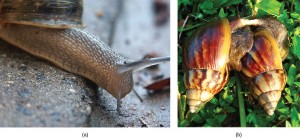
Sex activity Decision
Mammalian sex is adamant genetically past the combination of 10 and Y chromosomes. Individuals homozygous for X (Twenty) are female person and heterozygous individuals (XY) are male. In mammals, the presence of a Y chromosome causes the evolution of male person characteristics and its absenteeism results in female characteristics. The XY system is also plant in some insects and plants.
Bird sex determination is dependent on the combination of Z and W chromosomes. Homozygous for Z (ZZ) results in a male and heterozygous (ZW) results in a female person. Notice that this organization is the contrary of the mammalian system because in birds the female is the sex with the different sex chromosomes. The W appears to be essential in determining the sex of the individual, similar to the Y chromosome in mammals. Some fish, crustaceans, insects (such equally butterflies and moths), and reptiles use the ZW organization.
More complicated chromosomal sex determining systems likewise exist. For case, some swordtail fish have 3 sex chromosomes in a population.
The sex of another species is not determined by chromosomes, but past some aspect of the environment. Sex determination in alligators, some turtles, and tuataras, for case, is dependent on the temperature during the middle third of egg development. This is referred to as ecology sex determination, or more specifically, as temperature-dependent sexual activity determination. In many turtles, libation temperatures during egg incubation produce males and warm temperatures produce females, while in many other species of turtles, the reverse is true. In some crocodiles and some turtles, moderate temperatures produce males and both warm and absurd temperatures produce females.
Individuals of some species change their sex during their lives, switching from one to the other. If the private is female first, information technology is termed protogyny or "offset female," if information technology is male first, it is termed protandry or "outset male person." Oysters are born male person, grow in size, and become female person and lay eggs. The wrasses, a family of reef fishes, are all sequential hermaphrodites. Some of these species alive in closely coordinated schools with a dominant male and a big number of smaller females. If the male dies, a female increases in size, changes sexual practice, and becomes the new dominant male.
Fertilization
The fusion of a sperm and an egg is a process called fertilization. This can occur either inside (internal fertilization) or outside (external fertilization) the body of the female. Humans provide an case of the onetime, whereas frog reproduction is an instance of the latter.
External Fertilization
External fertilization usually occurs in aquatic environments where both eggs and sperm are released into the h2o. Subsequently the sperm reaches the egg, fertilization takes identify. Most external fertilization happens during the process of spawning where 1 or several females release their eggs and the male(s) release sperm in the same area, at the same time. The spawning may be triggered by environmental signals, such as water temperature or the length of daylight. Nearly all fish spawn, as practice crustaceans (such as crabs and shrimp), mollusks (such as oysters), squid, and echinoderms (such equally sea urchins and sea cucumbers). Frogs, corals, mayflies, and mosquitoes also spawn (Effigy 13.six).
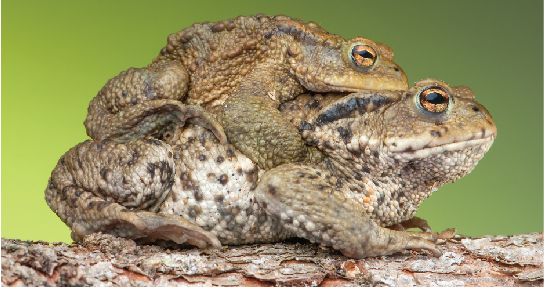
Internal Fertilization
Internal fertilization occurs well-nigh often in terrestrial animals, although some aquatic animals likewise apply this method. Internal fertilization may occur by the male person directly depositing sperm in the female during mating. Information technology may likewise occur by the male depositing sperm in the environment, usually in a protective structure, which a female person picks upward to deposit the sperm in her reproductive tract. At that place are three ways that offspring are produced post-obit internal fertilization. In oviparity, fertilized eggs are laid outside the female's torso and develop there, receiving nourishment from the yolk that is a role of the egg (Figure 13.7 a). This occurs in some bony fish, some reptiles, a few cartilaginous fish, some amphibians, a few mammals, and all birds. Virtually non-avian reptiles and insects produce leathery eggs, while birds and some turtles produce eggs with high concentrations of calcium carbonate in the beat, making them difficult. Chicken eggs are an case of a difficult vanquish. The eggs of the egg-laying mammals such equally the platypus and echidna are leathery.
In ovoviparity, fertilized eggs are retained in the female person, and the embryo obtains its nourishment from the egg's yolk. The eggs are retained in the female's body until they hatch inside of her, or she lays the eggs correct before they hatch. This procedure helps protect the eggs until hatching. This occurs in some bony fish (like the platyfish Xiphophorus maculatus, Figure 13.7 b), some sharks, lizards, some snakes (garter serpent Thamnophis sirtalis), some vipers, and some invertebrate animals (Republic of madagascar hissing cockroach Gromphadorhina portentosa).
In viviparity the immature are born alive. They obtain their nourishment from the female and are born in varying states of maturity. This occurs in about mammals (Figure 13.seven c), some cartilaginous fish, and a few reptiles.

Department Summary
Reproduction may be asexual when one private produces genetically identical offspring, or sexual when the genetic textile from ii individuals is combined to produce genetically diverse offspring. Asexual reproduction in animals occurs through fission, budding, fragmentation, and parthenogenesis. Sexual reproduction may involve fertilization inside the body or in the external environment. A species may have separate sexes or combined sexes; when the sexes are combined they may be expressed at different times in the life bike. The sexual practice of an individual may be determined by diverse chromosomal systems or environmental factors such as temperature.
Sexual reproduction starts with the combination of a sperm and an egg in a process called fertilization. This tin can occur either exterior the bodies or within the female person. The method of fertilization varies among animals. Some species release the egg and sperm into the environs, some species retain the egg and receive the sperm into the female person body and then expel the developing embryo covered with shell, while nevertheless other species retain the developing offspring throughout the gestation period.
Exercises
- In which group is parthenogenesis a normal upshot?
- chickens
- bees
- rabbits
- bounding main stars
- Genetically unique individuals are produced through ________.
- sexual reproduction
- parthenogenesis
- budding
- fragmentation
- External fertilization occurs in which type of environment?
- aquatic
- forested
- savanna
- steppe
- What might be a disadvantage to temperature-dependent sex determination?
- Compared to separate sexes and bold self-fertilizing is not possible, what might be one advantage and one disadvantage to hermaphroditism?
Answers
- B
- A
- A
- Temperatures tin vary from twelvemonth to twelvemonth and an unusually common cold or hot yr might produce offspring all of one sex, making it hard for individuals to find mates.
- A possible reward of hermaphroditism might exist that anytime an individual of the aforementioned species is encountered a mating is possible, unlike split sexes that must find an individual of the right sex to mate. (Also, every individual in a hermaphrodite population is able to produce offspring, which is not the example in populations with separate sexes.) A disadvantage might be that hermaphrodite populations are less efficient considering they exercise not specialize in one sex or some other, which means a hermaphrodite does not produce as many offspring through eggs or sperm as practise species with separate sexes. (Other answers are possible.)
Glossary
asexual reproduction:a machinery that produces offspring that are genetically identical to the parent
budding:a form of asexual reproduction that results from the outgrowth of a function of an organism leading to a separation from the original animal into two individuals
external fertilization:the fertilization of eggs past sperm exterior an animal's body, often during spawning
fission:(besides, binary fission) a course of asexual reproduction in which an organism splits into 2 split up organisms or 2 parts that regenerate the missing portions of the body
fragmentation:the breaking of an organism into parts and the growth of a divide individual from each office
hermaphroditism:the state of having both male and female person reproductive structures within the same individual
internal fertilization:the fertilization of eggs past sperm inside the body of the female
oviparity:a procedure by which fertilized eggs are laid exterior the female'south body and develop at that place, receiving nourishment from the yolk that is a office of the egg
ovoviparity:a process by which fertilized eggs are retained within the female person; the embryo obtains its nourishment from the egg's yolk, and the young are fully adult when they are hatched
parthenogenesis:a form of asexual reproduction in which an egg develops into a consummate private without being fertilized
sexual activity decision:the machinery by which the sex of individuals in sexually reproducing organisms is initially established
sexual reproduction:a form of reproduction in which cells containing genetic fabric from ii individuals combines to produce genetically unique offspring
viviparity:a process in which the young develop within the female person and are born in a nonembryonic state
Source: https://opentextbc.ca/biology/chapter/13-1-how-animals-reproduce/
Posted by: newmanabings1964.blogspot.com

0 Response to "What Animal Can Have As Many As 15 Sexes"
Post a Comment